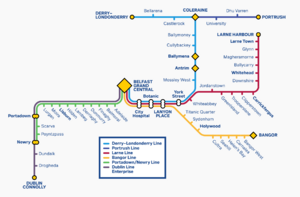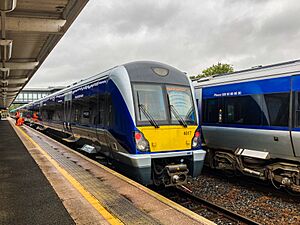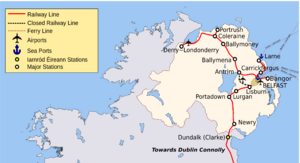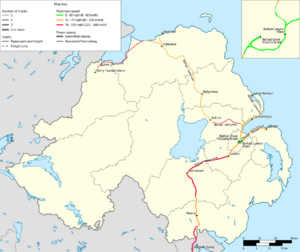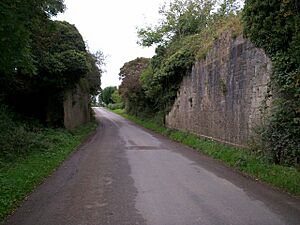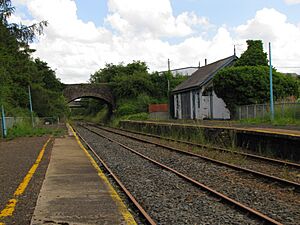NI Railways facts for kids
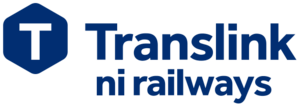 |
|||
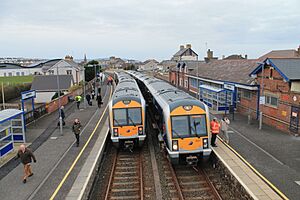
Class 3000 trains at Castlerock
|
|||
| Overview | |||
|---|---|---|---|
| Main region(s) | Northern Ireland | ||
| Fleet size | 47 | ||
| Stations called at | 54 | ||
| Parent company | NITHCo (Translink) | ||
| Dates of operation | 1967– | ||
| Predecessor | Ulster Transport Authority | ||
| Technical | |||
| Track gauge | 1,600 mm (5 ft 3 in) Irish gauge | ||
| Electrification | Unelectrified Network | ||
| Length | 333 kilometres (207 mi) | ||
| Operating speed | National speed limit: 90 mph (145 km/h) | ||
|
|||
NI Railways, also known as Northern Ireland Railways (NIR), is the main train company in Northern Ireland. It is part of a bigger group called Translink. Translink also includes bus services like Ulsterbus and Metro.
NI Railways is special because it's one of the few train companies in the United Kingdom that manages everything itself. This means it runs the trains, fixes them, and looks after the tracks. The trains in Northern Ireland use a special track width called Irish gauge. This is different from the tracks in Great Britain.
NI Railways works with Iarnród Éireann, the train company in the Republic of Ireland. Together, they run the Enterprise train service. This service connects Belfast in Northern Ireland with Dublin in the Republic of Ireland. In 2019, over 15 million people traveled with NI Railways.
Contents
A Look Back: The History of NI Railways
How Railways Started in Northern Ireland
Before 1948, there were three main railway companies in Northern Ireland. These were the Great Northern Railway Ireland (GNRI), the Northern Counties Committee (NCC), and the Belfast and County Down Railway (BCDR).
In 1948, a new group called the Ulster Transport Authority (UTA) was created. The UTA took over these railway companies. Under the UTA, the railway network in Northern Ireland became much smaller. It went from about 900 miles (1,450 km) of track to just 225 miles (362 km).
The Birth of NI Railways
In 1967, the UTA was split into separate train and road companies. This is when Northern Ireland Railways (NIR) was officially formed. For a while, the railway network faced many challenges. Tracks and trains were old and needed a lot of repairs. The last steam trains were stopped in 1970.
New Trains and Services
In 1970, NI Railways brought back the popular Enterprise service. They used new NIR Class 101 diesel trains and modern carriages. This service has continued to run, connecting Belfast and Dublin.
In the 1970s, the Class 80 trains were introduced. These trains were known for their unique "thumping" sound. They served many routes around Belfast and stayed in use until 2012. Later, in the 1980s, NI Railways also bought Class 450 trains. These were also diesel trains and were used until 2012.
Since 2002, NI Railways has been updating its trains. They bought new trains from a Spanish company called CAF. The first new trains were 23 Class 3000 units, delivered in 2004 and 2005. These trains offered more space and were easier to access. After that, 20 Class 4000 trains were delivered between 2010 and 2012. These new trains replaced all the older ones.
In 2021, Translink updated its company logos. This included a new look for NI Railways. The new design was made to look more modern and simple.
How Well NI Railways Performs
NI Railways aims to be on time for its services. For the 26 weeks leading up to March 30, 2025, trains were on time 96.2% of the time. The Portadown/Newry Line was the most punctual, at 97.8%.
In 2014–2015, NI Railways carried 13.4 million passengers. This was a big increase from 10.4 million passengers in 2010–2011. The company earned £43.6 million from ticket sales in 2014–2015.
In 2018–2019, NI Railways had its busiest year ever. It carried 15.8 million passengers. However, during the COVID-19 pandemic, passenger numbers dropped a lot due to travel restrictions. By 2022–2023, numbers started to recover, reaching 11.5 million passengers.
| Year | Total |
|---|---|
| 2010 - 2011 | |
| 2011 - 2012 | |
| 2012 - 2013 | |
| Final ageing 80 and 450 Class trains are replaced with modern C4K railcars | |
| 2013 - 2014 | |
| 2014 - 2015 | |
| 2015 - 2016 | |
| 2016 - 2017 | |
| 2017 - 2018 | |
| NI Railways' 50th Anniversary | |
| 2018 - 2019 | |
| COVID-19 pandemic begins, bringing with it long periods of travel restrictions | |
| 2019 - 2020 | |
| 2020 - 2021 | |
| 2021 - 2022 | |
| End of COVID-19 travel restrictions | |
| 2022 - 2023 | |
The Trains: What NI Railways Uses
Current Trains
NI Railways uses modern trains for its passengers.
| Class | Image | Type | Top speed | Number Delivered | Routes operated | Built | |
|---|---|---|---|---|---|---|---|
| mph | km/h | ||||||
| Passenger fleet | |||||||
| Class 3000 |  |
Diesel multiple unit | 90 | 145 | 23 | Belfast – Derry~Londonderry Belfast – Newry Belfast – Bangor Belfast – Larne Coleraine – Portrush Belfast – Dublin (Enterprise) |
2003–2005 |
| Class 4000 |  |
20 | Belfast – Derry~Londonderry Belfast – Newry Belfast – Bangor Belfast – Larne Coleraine – Portrush |
2010–2021 | |||
| Infrastructure fleet | |||||||
| 111 Class |  |
Diesel locomotive | 90 | 145 | 3 | Infrastructure duties | 1980–1984 |
| 201 Class |  |
Diesel locomotive | 102 | 164 | 2 | Belfast - Dublin (Enterprise) Infrastructure duties |
1994–1995 |
| MPV |  |
Diesel multiple unit | 62 | 100 | 1 | Sandite duties | 2016 |
| Only 6 Class 3000 units are equipped with CAWS, which allows them to operate in the Republic of Ireland. | |||||||
NI Railways also shares ownership of the special carriages used for the Enterprise service between Belfast and Dublin. These carriages have their own unique look.
In 2015, Translink bought a new special vehicle from Windhoff Bahn AG. This vehicle is used for tasks like spraying sand on the tracks to help trains grip better, especially when leaves fall. It also helps with high-pressure water spraying and weed killing.
New Trains for the Future
In 2004 and 2005, NI Railways received 23 new Class 3000 diesel trains from Spain. These trains cost £80 million. All of them were in service by September 2005.
Then, in 2007, NI Railways planned to buy even more trains. These new trains, called Class 4000, replaced the older Class 80 and Class 450 trains by March 2012. The first Class 4000 trains arrived in March 2011 and started service in September 2011.
In December 2018, NI Railways announced they would buy 21 more carriages. These carriages cost £50 million. They are used to make some of the Class 4000 trains longer, from three cars to six cars. The first new carriages arrived in March 2021 and started service in September 2021. This adds much more space for passengers.
Past Trains
NI Railways has used many different types of trains over the years.
| Class | Image | Type | Built | Withdrawn | Notes |
| Class Z |  |
Steam locomotive | 1949 | 1969 | These were steam trains. |
| Class WT | 1946–1950 | 1969–1971 | These steam trains were nicknamed "Jeeps." They were used for many different jobs. | ||
| AEC |  |
Diesel multiple unit | 1948–1950 | 1972 | 10 of these trains came from the UTA. |
| BUT |  |
1956–1958 | 1975–1980 | Some of these were changed to be pulled by other trains. | |
| MED |  |
1952–1954 | 1973–1978 | Used for local services around Belfast. | |
| MPD |  |
1957–1962 | 1981–1984 | Used for longer trips and the Enterprise service. | |
| 70 Class |  |
1966–1968 | 1985–1986 | Passenger trains. Their engines were later used in 450 Class units. | |
| 80 Class |  |
1974–1979 | 2011–2017 | Passenger trains nicknamed 'Thumpers'. They ran on all routes. | |
| 101 Class |  |
Diesel locomotive | 1970 | 2002 | Used for pulling Enterprise trains. |
| 104 Class |  |
1956–1957 | 1997 | Six of these trains came from another company in 1986. | |
| 450 Class |  |
Diesel multiple unit | 1985–1987 | 2011–2012 | Passenger trains nicknamed the Castle Class. They were named after Northern Ireland castles. |
| RB3 |  |
Diesel railcar | 1980 | 1990 | A test train from British Rail. |
| Class 1 |  |
Diesel locomotive | 1969 | 1989 | These were shunting trains, used for moving carriages around. |
| Mark 2 'Gatwicks' | Passenger Carriage | 1973 | 2009 | Bought in 2001 and used on the Belfast-Portadown route. |
Train Routes Across Northern Ireland
NI Railways runs trains on several important lines:
- Bangor Line: This line goes northeast from Belfast to the seaside town of Bangor.
- Derry~Londonderry Line: This is the longest line entirely within Northern Ireland. It connects Belfast to Derry~Londonderry.
- Dublin Line: This line goes south from Belfast into the Republic of Ireland to Dublin. The Enterprise service runs on this line.
- Larne Line: This line goes north from Belfast, mostly along the coast, to Larne Harbour. You can connect to ferry services here.
- Newry Line: This line goes southwest from Belfast, through towns in Counties Down and Armagh.
- Portrush Line: This is a short line connecting Coleraine and Portrush. It's the only line that doesn't go into Belfast.
- Lisburn–Antrim line: This line is currently not used for regular passenger services. It is kept for training and as a backup route.
Many lines share tracks near Belfast. For example, the Bangor, Derry~Londonderry, and Larne lines all use the same track from Grand Central to Lanyon Place.
Train Services
NI Railways runs regular passenger trains on weekdays. Here's a look at some of the services:
| Northern Ireland Railways |
|||
|---|---|---|---|
| Route | tph | Calling at | |
| Belfast – Bangor | 2 | City Hospital, Botanic, Belfast Lanyon Place, Titanic Quarter, Sydenham, Holywood, Marino, Cultra, Seahill, Helen's Bay, Carnalea, Bangor West | |
| Belfast – Derry~Londonderry | 1 |
|
|
| Belfast – Portadown and Newry | 2 |
|
|
| Belfast – Whitehead and Larne Harbour | 2 |
|
|
| Coleraine – Portrush | 1 |
|
|
| Enterprise | |||
| Route | tph | Calling at | |
| Belfast – Dublin Connolly | 1 |
|
|
Routes Not Currently Used
The Lisburn-Antrim railway line stopped passenger services in June 2003. This happened after a new route opened that made journeys faster between Derry, Coleraine, Ballymena, Antrim, and Belfast. The Lisburn-Antrim line is still kept in good condition. It is sometimes used for training or as a backup route if other lines are closed.
The Future of Railways in Northern Ireland
Improving railways in Northern Ireland is important for the region's economy. It also helps reduce traffic on roads. One challenge for NI Railways is having enough trains during busy times. If a train breaks down, it can cause delays across the whole network.
Since 1998, the Northern Ireland Assembly has invested a lot of money in railways. This included buying the new Class 3000 trains and building a new maintenance depot. In 2004, a "Strategic Rail Review" looked at how to improve services even more. It found that all lines, even less busy ones, are important.
In May 2007, there were discussions about how to make the railway network better. Ideas included:
- Reopening lines that are currently closed, like the Lisburn-Antrim railway line.
- Improving the Belfast-Derry~Londonderry line. This would mean adding more places for trains to pass each other and upgrading the tracks for faster speeds.
Some groups want to protect old railway routes. Even if the tracks are gone, they want to keep the land clear. This way, the lines could be rebuilt in the future for commuters.
In October 2007, the government announced that about £137 million would be spent on railways between 2008 and 2011. This money helped with major improvements.
In June 2008, a transport researcher suggested a big plan to expand the network. This plan, called Northern Ireland Network Enhancement (NINE), would cost £460 million. It suggested reopening lines to towns that haven't had train services for many years, like Omagh and Strabane. However, these big plans are not set to happen in the next decade.
Translink also plans to introduce a new ticketing system. This will include ticket machines at stations and a "smart card" system. This system will be similar to the Leap Card used in the Republic of Ireland.
Improving Tracks and Stations
The railway network mainly focuses on Greater Belfast. The Bangor and Larne lines have been updated recently. This has allowed for better train schedules.
The Belfast-Derry line is mostly a single track. This limits how often trains can run and how fast they can go. A group called Into the West wants better rail links to the North West region. They believe good train services are vital for the economy there.
In November 2007, the government announced plans to upgrade the Belfast-Londonderry line north of Coleraine. This project cost £64 million and started in 2011. It included new signals and a new crossing loop. Once finished in 2016, it allowed for faster journeys between Belfast and Derry~Londonderry.
NI Railways also built a new train maintenance depot next to Adelaide station. This helps keep the trains in good condition.
Connecting Portadown to Armagh
In 2013, there was talk about reopening the train route between Portadown and Armagh. This would help connect Armagh to the railway network again.
Train Links to Airports
There have been suggestions to reopen the Lisburn-Antrim railway line. This line passes close to Belfast International Airport. A new station could be built to serve the airport. This would also help the towns in South Antrim grow.
There have also been calls for a train station near City of Derry Airport. This airport is close to the railway line. However, the government has decided that not enough passengers use the airport to justify building a station there.
Future Trains
Translink has a plan to have zero-emission train services by 2040. As part of this, NI Railways will start buying new trains from 2026 to 2027. They plan to get 15 new three-car units for their own services. They also plan to get 9 eight-car sets for the Enterprise service. These new trains will use zero or low-carbon technologies.
Images for kids
See also
 In Spanish: NI Railways para niños
In Spanish: NI Railways para niños


